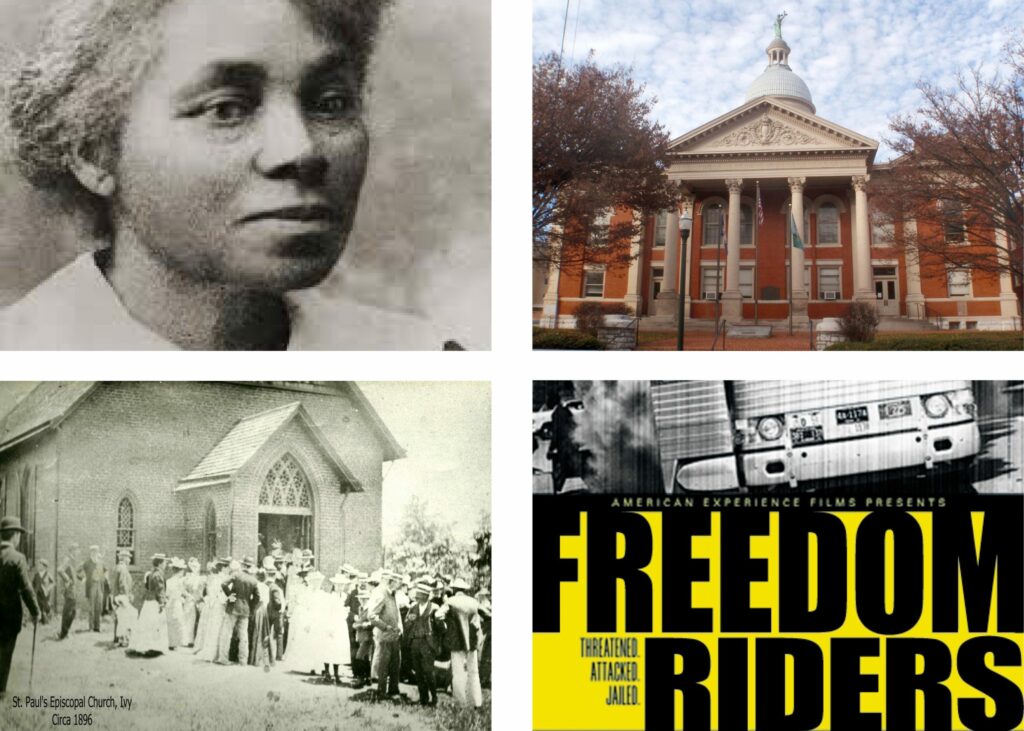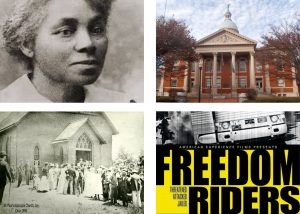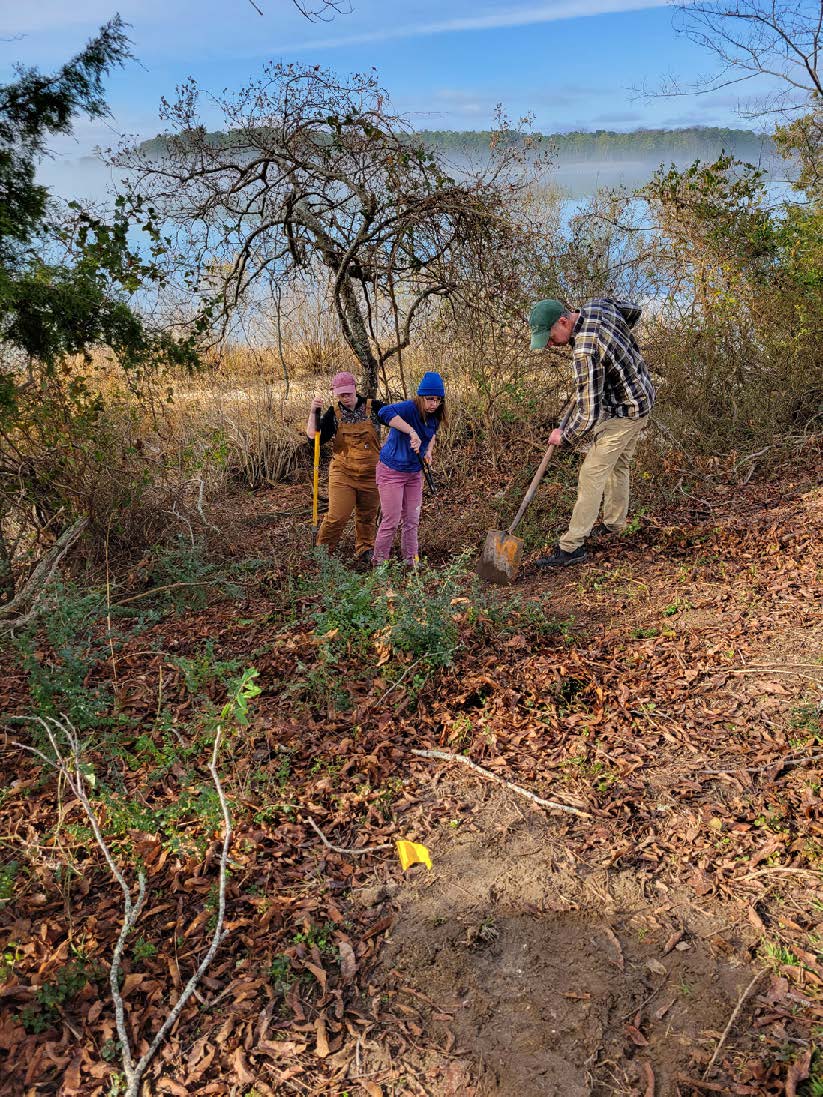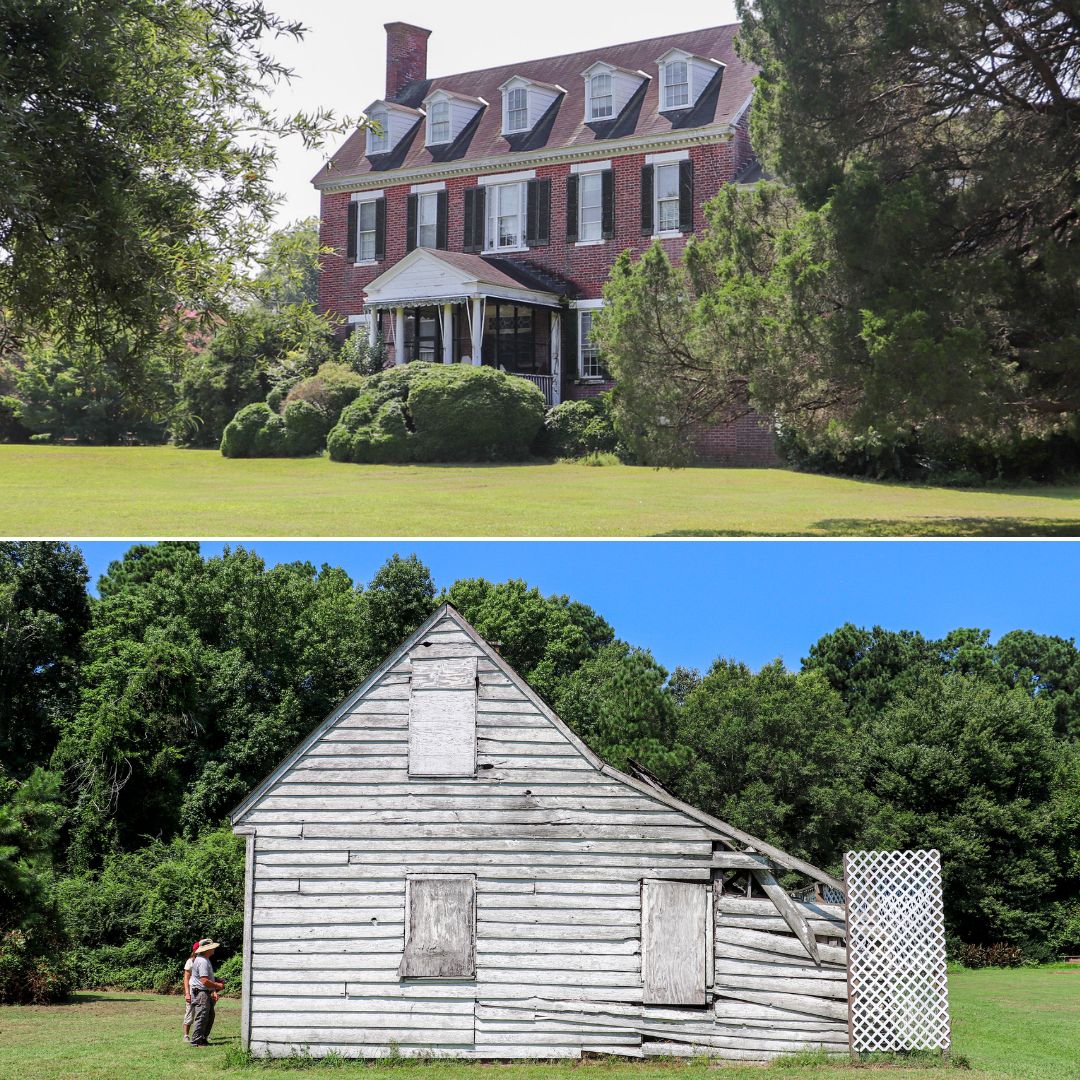16 New State Historical Highway Markers Approved

 —Markers cover topics in the counties of Albemarle, Alleghany (2), Chesterfield, Goochland, Highland, Loudoun, Pittsylvania, and Tazewell; and the cities of Alexandria, Bristol, Fredericksburg, Harrisonburg, Martinsville, Petersburg, and Staunton—
—Markers cover topics in the counties of Albemarle, Alleghany (2), Chesterfield, Goochland, Highland, Loudoun, Pittsylvania, and Tazewell; and the cities of Alexandria, Bristol, Fredericksburg, Harrisonburg, Martinsville, Petersburg, and Staunton—
Sixteen proposed historical markers approved for manufacture recall people, places or events from Virginia’s colonial era to the 1960s, with topics drawing on Virginia’s African American, political, educational, and social history, among other threads.
The Virginia Board of Historic Resources approved the marker texts during a March 18 public quarterly meeting hosted virtually by the Department of Historic Resources (DHR).
Five of the forthcoming markers highlight schools or Black educators who had influential and significant careers during segregation:
- In Goochland County, Central High School, the county’s only high school for Black students, opened in 1938 and replaced a 1923 Rosenwald school that had burned in 1937; a grant from the New Deal’s Public Works Administration supported construction of the six-room Central High, which the county desegregated in 1969.
- Opened in 1928, the Rosenwald Fund supported the Dry Bridge School in Henry County (now part of Martinsville); a local African American educational organization pushed for its construction to replace an older school building; the school (grades 1-8) closed in 1968 under desegregation.
- Lucy F. Simms, born enslaved, earned a teaching certificate from Hampton Normal and Agricultural Institute (now Hampton University) in 1877; she returned to Rockingham Co. and Harrisonburg, where she was raised, and taught an estimated 1,800 students during her 56-year career. In 1938, the city posthumously named a school for her.
- Bristol native Dr. Charles Spurgeon Johnson, a sociologist, author, civil rights leader, and World War I veteran, was a scholar on race relations. He was a driving force behind the Harlem Renaissance as editor of Opportunity magazine, and became Fisk University’s first Black president in 1947.
- R. Arliner Young, born in Clifton Forge, became in 1940 the first African American woman to earn a doctorate in zoology at the University of Pennsylvania. She taught zoology at Howard University for many years and conducted research at the elite Marine Biological Laboratory in Massachusetts.
Jurisdictional, statutory, or political Virginia history will be recalled in four markers:
- The “Augusta County Courthouse” in Staunton traces to the General Assembly’s creation of the county in 1738, when it theoretically extended to the Pacific Ocean. The county court first met in a log courthouse. The current courthouse, which prominent regional architect T. J. Collins designed in the Beaux-Arts and Neo-Classical Revival style, completed in 1901, is the fifth courthouse erected on the site.
- The marker “Restored Government of Virginia” relays that Unionists established a state government under Gov. Francis H. Pierpont that remained loyal to the U.S. during the Civil War. The Restored Government eventually relocated to Alexandria. Its Virginia Constitution of 1864 abolished slavery and secured other reforms.
- In 1879, a federal marshal arrested Pittsylvania County Judge James Coles in Chatham for violating the Civil Rights Act of 1875 by refusing to seat Black men on juries; that arrest led the Commonwealth of Virginia to petition the U.S. Supreme Court to release Coles. In response, the court ruled in Ex Parte Virginia (1880) that the Constitution’s 14th Amendment empowered Congress to enforce the right of Black citizens to serve on juries—a ruling often ignored subsequently.
- The Readjuster Party, a biracial coalition led by former Confederate general William Mahone, is the focus of a marker to rise in Petersburg. The Readjusters gained control of the General Assembly in 1879, and, in 1882, refinanced Virginia’s massive antebellum debt, increased funding for public education, and abolished the poll tax. African American support was key to the party’s success, but ultimately the party withered after Democrats successfully campaigned against it by leveraging white fears of African American power.
Civil War history lies at the heart of a marker in Highland County about McDowell Presbyterian Church. Its congregation, first organized in 1822, constructed the current brick sanctuary around 1856. During the Battle of McDowell, on May 8, 1862, the church served as a hospital, and Union and Confederate dead reportedly were buried in the church cemetery.
The lives of African Americans during Reconstruction and the era of Jim Crow segregation are glimpsed in four other markers.
- Willisville in Loudoun County arose in the late 1860s around a small group of dwellings where free and enslaved people had lived before the Civil War. In 1868, community residents erected a building to serve as a school and church with the support of the Freedmen’s Bureau. Land ownership anchored residents to the community as they purchased lots during the 1870s. Today, the Willisville Historic District is listed on the Virginia and National landmark registers.
- A marker for Tazewell County’s Town of Bluefield highlights the one-time “colored section” of the Maple Hill Cemetery, where about 300 African Americans were buried between the 1890s and 1950s. African Americans have had a significant presence since the founding of Tazewell County, where 10 percent of the population in 1800 was Black. Coal mines and railroads attracted Black laborers to the county and they helped build Bluefield.
- The US Forest Service established Green Pastures Recreation Area in Alleghany County after the NAACP descried the lack of outdoor facilities for African Americans, since nearby Douthat State Park admitted whites only. The Civilian Conservation Corps built a lake, a beach, picnic areas, hiking trails, and more between 1938 and 1940, and Green Pastures drew African Americans from around the region.
- Civil Rights–era activism centers on a marker destined for Fredericksburg. The Congress of Racial Equality organized Freedom Rides in 1961 to challenge racial segregation in interstate bus travel, which persisted despite U.S. Supreme Court decisions barring it. After departing from Washington, D.C. on May 4, the Freedom Riders first stopped at a Fredericksburg Greyhound Bus Terminal, where they integrated the restrooms and lunch counter before resuming their southbound travel to New Orleans.
The Board of Historic Resources, the entity authorized to designate new state historical markers, also approved two other markers during its March meeting:
- The “Sale of Enslaved People at Oakland” tells about an auction at which William Ransom Johnson sold 46 enslaved men, women, and children at his Oakland plantation in Chesterfield County in 1845 to ease his financial troubles. Splintering several enslaved families, the sale is representative of Virginia’s antebellum economy when such transactions were commonplace.
- The Rev. Frederick W. Neve will be remembered with a marker in Albemarle County. Between 1890 and 1935, Neve established more than 30 missions, many with schools and hospitals, in the Blue Ridge and Ragged Mountains. Appointed as the Episcopal Church’s Archdeacon of the Blue Ridge in 1904, Neve later organized The Order of the Thousandfold, a worldwide prayer ministry.
After approval by the Board of Historic Resources, it can take upwards of three months or more before a new marker is ready for installation. The marker’s sponsor covers the required $1,770 manufacturing expenses for a new sign.
Virginia’s historical highway marker program began in 1927 with installation of the first markers along U.S. 1. It is considered the oldest such program in the nation. Currently there are more than 2,600 state markers, mostly maintained by the Virginia Department of Transportation, except in those localities outside of VDOT’s authority.
See more information about the Historical Highway Marker Program on the DHR website.
Full Text of Markers:
(VDOT must approve the proposed locations for each sign or public works in jurisdictions outside VDOT’s authority.)
Central High School
Central High School, Goochland County’s only high school for African American students, opened here in 1938. It replaced Fauquier Training School, which stood across the street from 1923, when construction was completed with support from the Julius Rosenwald Fund, until it burned in 1937. Central High, a six-room brick building that was later enlarged, was built on an 11-acre site with a grant from the Public Works Administration, a New Deal agency. Its academic, social, and cultural programs were central to the community. After the county desegregated its schools under federal court order in 1969, the building became a junior high school.
Sponsor: Goochland County
Locality: Goochland County
Proposed Location: 2748 Dogtown Road
Dr. Charles Spurgeon Johnson (1893-1956)
Charles S. Johnson, sociologist, author, and civil rights leader, was born in Bristol, son of a 42-year pastor of Lee Street Baptist Church. He attended Virginia Union University and the University of Chicago and served in combat during World War I. A scholar of race relations, he was the primary author of a seminal analysis of the Chicago race riots of 1919. He became the first director of research at the National Urban League and was a driving force behind the Harlem Renaissance as editor of Opportunity magazine. At Fisk University, Johnson led the social sciences department, published widely, and established annual Race Relations Institutes. In 1947 he became Fisk’s first Black president.
Sponsor: Bristol Historical Association
Locality: Bristol
Proposed Location: Cumberland Park, near the corner of Lee and Cumberland Streets
Dry Bridge School
Henry County opened a new Dry Bridge School just south of here in 1928 after the School Improvement League, an organization of African Americans living east of Martinsville, campaigned under the leadership of the Rev. W. F. Geter to replace the original Dry Bridge Colored School. Funding came from the African American community, the public, and the Julius Rosenwald Fund, which helped build more than 5,000 schools for African Americans in the South. The school, led by teaching principals J. L. Hairston and the Rev. R. T. Anderson, served students in grades 1-8. Known as East Martinsville School after the city annexed this area in 1948, it was closed in 1968 as the city desegregated its schools.
Sponsor: Imogene Hodge Draper
Locality: City of Martinsville
Proposed Location: East Church Street, just east of Boden Street intersection
Ex Parte Virginia
Here in March 1879, a federal marshal arrested James Coles, Pittsylvania County judge, on charges that he had violated the Civil Rights Act of 1875 by refusing to seat Black men on juries. Coles and the Commonwealth of Virginia petitioned the U.S. Supreme Court for his release, arguing that Congress had no authority to regulate state juries. Denying the petition, the court ruled in Ex Parte Virginia (1880) that the 14th amendment to the U.S. Constitution empowered Congress to enforce the right of Black citizens to serve on juries. The ruling, though often disregarded in subsequent decades, demonstrated the broad promise of the 14th amendment to protect the civil rights of all Americans.
Sponsor: Pittsylvania Historical Society
Locality: Pittsylvania County
Proposed Location: 1 North Main Street, Chatham
Sale of Enslaved People at Oakland
Slave sales, a foundation of Virginia’s antebellum economy and a commonplace occurrence in a society that regarded human beings as property, brought terror to the enslaved. William Ransom Johnson sold 46 enslaved men, women, and children at an auction at his Oakland plantation near here on 25 March 1845. Johnson’s auction, precipitated by financial trouble and poor health, attracted 18 purchasers who paid a total of $16,705.50 and splintered several families. Petersburg slave trader Henry Davis, who regularly shipped slaves to the markets in New Orleans, bought ten people. After Johnson’s death in 1849, his executor held another auction here in which 24 enslaved people were offered for sale.
Sponsor: Pegram Johnson
Locality: Chesterfield County
Proposed Location: River Road (Rte. 602) near intersection with Cedar Creek Road
Willisville
Willisville, 1.5 miles north, developed in the late 1860s around a small group of dwellings where free and enslaved African Americans had lived before the Civil War. In 1868, residents erected a building to serve as a school and church with support from Richard H. Dulany of Welbourne and the Freedmen’s Bureau. Land ownership anchored residents to the community as they began purchasing lots in the 1870s. The village was likely named for Henson Willis, the first person known to be buried in the Old Willisville Cemetery (ca. 1873). The Willisville Historic District includes the school (built in 1921 after the original building burned), Willisville Store (1922-24), and Willisville Chapel (1924).
Sponsor: Willisville Preservation Foundation
Locality: Loudoun County
Proposed Location: South side of Rt. 50 at the intersection of Rt. 50 and Willisville Rd.
Lucy F. Simms (ca. 1856–1934)
Lucy F. Simms was born enslaved and grew up in present-day Harrisonburg. She earned a teaching certificate from Hampton Normal and Agricultural Institute (later Hampton University) in 1877. Like fellow Hampton graduate Booker T. Washington, Simms dedicated her life to education. After teaching for a year in rural Rockingham County, she accepted a position in Harrisonburg. During her 56-year career, she taught an estimated 1,800 students spanning several generations. In 1939, the City of Harrisonburg opened the Lucy F. Simms School near her childhood home. Simms was selected in 2017 to be one of ten Virginians represented on the Emancipation Proclamation and Freedom Monument in Richmond.
Sponsor: City of Harrisonburg
Locality: Harrisonburg
Proposed Location: 620 Simms Ave.
Maple Hill Cemetery, African American Section
About 300 African Americans, including some who had been born enslaved, were interred here in the “colored section” of Maple Hill Cemetery between the 1890s and the mid-20th century. African Americans had been a significant presence in Tazewell County since its founding, representing more than 10 percent of the population in 1800. After emancipation, many remained in this area. Later in the 19th century, coal mines and railroads drew African Americans here from other regions. They helped build the town of Graham (later Bluefield), often working as brick and stone masons, cooks, and midwives. In 2006 a fence dividing the cemetery’s white and neglected black sections was removed.
Sponsor: Susie M. Green
Locality: Town of Bluefield (Tazewell County)
Proposed Location: at cemetery, near Virginia Ave. and Luther St.
First Stop on 1961 Freedom Rides
The Congress of Racial Equality, led by James Farmer, organized the Freedom Rides in 1961 to challenge racial segregation in interstate bus travel, which had persisted despite U.S. Supreme Court decisions barring segregation in seating (1946) and in terminal facilities (1960). After departing from Washington, D.C., on the morning of 4 May, the Freedom Riders first stopped here at the Greyhound Bus Terminal, where they integrated the restrooms and lunch counter without incident. As the riders traveled toward New Orleans, they encountered brutal resistance and arrest. Hundreds joined the campaign, prompting the Interstate Commerce Commission to issue new regulations enforcing desegregation.
Sponsor: City of Fredericksburg and University of Mary Washington
Locality: City of Fredericksburg
Proposed Location: 601 Princess Anne St.
The Rev. Frederick W. Neve (1855-1948)
The Rev. Frederick W. Neve, born in England and educated at Oxford, came to Virginia in 1888 to serve as rector of St. Paul’s Episcopal Church, here, and Emmanuel Church in Greenwood. Between 1890 and 1935, he established more than 30 missions, many with schools and hospitals, in the Blue Ridge and Ragged Mountains. At first traveling by horseback, he brought worship, literacy, education, and medical care to families living in remote areas. He recruited and trained dozens of mission workers, primarily women from outside the region. Neve, appointed Archdeacon of the Blue Ridge in 1904, later organized The Order of the Thousandfold, a worldwide prayer ministry. He is buried here at St. Paul’s.
Sponsor: St. Paul’s (Ivy) Episcopal Church
Locality: Albemarle County
Proposed Location: 851 Owensville Road, Charlottesville
Augusta County Courthouse
Augusta County, created by the Virginia General Assembly in 1738, was formally organized in 1745. Its original western boundary stretched “to the utmost limits of Virginia,” a claim that then extended to the Pacific Ocean. The county court first met in a log courthouse that William Beverley built on his property here. John Madison served as the county’s first clerk of court from 1745 to 1778. Prominent regional architect T. J. Collins designed the current courthouse, the fifth on this site, in the Beaux-Arts and Neo-Classical Revival styles. The building, completed in 1901, was listed on the Virginia Landmarks Register and the National Register of Historic Places in 1982.
Sponsor: Augusta County Historical Society
Locality: Staunton
Proposed Location: 1 East Johnson Street
McDowell Presbyterian Church
This congregation, first known as Central Union Church, was organized in 1822. The present brick sanctuary, an interpretation of the Greek Revival style, replaced an earlier structure ca. 1856. The entrance on the building’s south side was likely for the use of free and enslaved African Americans, who worshiped from the balcony. During the Battle of McDowell on 8 May 1862, the church served as a hospital. Union and Confederate dead were reportedly buried in the congregation’s cemetery across present-day Route 250. The church is listed on the American Presbyterian and Reformed Historic Sites Registry, the Virginia Landmarks Register, and the National Register of Historic Places.
Sponsor: McDowell Presbyterian Church
Locality: Highland County
Proposed Location: behind church along Bullpasture River Rd., near intersection with Highland Turnpike
Green Pastures Recreation Area
In 1937, after the Clifton Forge chapter of the NAACP decried the lack of outdoor recreation areas for African Americans, the U.S. Forest Service agreed to open a new park here for Black patrons, who were not then welcome in nearby Douthat State Park. The Civilian Conservation Corps (CCC) constructed Green Pastures between 1938 and 1940. With a lake, a beach, picnic areas, hiking trails, and recreational fields, the facility was popular with families, civic clubs, church groups, and other visitors from across the region. Although officially desegregated in 1950, the park was predominantly used by African Americans until the 1960s, when it was renamed Longdale Recreation Area.
Sponsor: Department of Historic Resources
Locality: Alleghany County
Proposed Location: TBD
Readjuster Party
The Readjuster Party, a biracial coalition led by former Confederate general William Mahone, won control of the Virginia General Assembly in 1879. The party’s main objective, accomplished in 1882, was to refinance the state’s massive antebellum debt and increase funding for public education. The Readjusters also abolished the poll tax, eliminated whipping as a punishment for crime, and established what is now Virginia State University. African American support for the party, cemented at a convention at the Academy of Music on this site in 1881, was crucial to its success. The Readjusters lost the General Assembly in 1883 after Democrats campaigned on white fears of African American power.
Sponsor: Department of Historic Resources
Locality: Petersburg
Proposed Location: W. Bank St. at old St. Paul’s Alley
Restored Government of Virginia
After Virginia seceded in the spring of 1861, Unionists met in Wheeling and organized a state government loyal to the U.S. under Gov. Francis H. Pierpont. The Restored Government, which sent representatives to the U.S. Congress and raised federal troops, moved to Alexandria in Aug. 1863. Pierpont was based at the City Hotel (Gadsby’s Tavern) before moving to 415 Prince St. The General Assembly, representing Northern Virginia, the Eastern Shore, and Hampton Roads, met at City Hall. Members authorized a convention that adopted Virginia’s Constitution of 1864, which abolished slavery and secured other reforms. The government moved to Richmond in May 1865; its constitution was in effect until 1869.
Sponsor: Department of Historic Resources
Locality: Alexandria
Proposed Location: TBD
Roger Arliner Young (1898-1964)
R. Arliner Young, zoologist, was born in Clifton Forge. After graduating with a B.A. from Howard University and an M.S. from the University of Chicago, she became the first African American woman to earn a doctorate in zoology when she completed her Ph.D. at the University of Pennsylvania in 1940. Her research focused on the effects of electromagnetic radiation on marine organisms, and her 1924 article in the journal Science won international attention. For years she taught zoology at Howard and conducted research at the elite Marine Biological Laboratory in MA. She later taught at other historically Black colleges and universities and was a civil rights activist and labor union organizer.
Sponsor: Department of Historic Resources
Locality: Alleghany County
Proposed Location: near Clifton Forge










